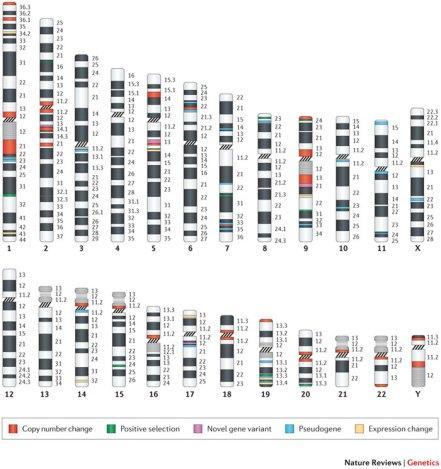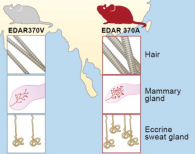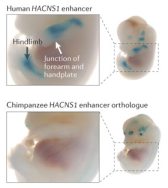Some segments of the genome are crucial to survival and so any changes to these regions, even small ones, can prove fatal. These means that these sequences don’t change much over the course of evolution and so are very similar in all animals, regardless of how related they are to each other. However, some of these “conserved” regions have undergone significant changes in humans. As such one of these genes may be almost identical in chimpanzees and chickens, but will be the human variant will be very different.
These uniquely human areas of the genome are known as the “human accelerated region” (HAR). There are also segments of the human genome which have undergone changes in us but are not conserved in other animals. These are called “human lineage specific changes” (HLS). Since both HAR and HLS regions are unique to humans, it makes sense to conclude that these are somehow responsible for our unique traits; such as large brains, flat faces and so on. Whilst it is quite easy to identify where these changes are (since you just have to compare our genome to those of other animals), figuring out what these changes do is much harder.

The location of genes which have changed over the course of human evolution
As such a lot of research has focused on trying to identify precisely what these genes do and how they make you, you. Alas this process has been slowed down by that damnable thing known as morality. Genetically engineering youngsters without these genes to see what traits disappear is sadly out of the question, forcing scientists to take roundabout routes. For example, the gene EDARV370A has undergone recent positive selection Chinese populations, suggesting it helped our species adapt to the new conditions we found when we migrated into East Asia. To identify what it did, scientists gave the human variant to mice!

The effects of giving the human variant to a mouse
They found that it resulted in thicker hair, increased sweat gland density, as well as altering tooth shape and mammary glands. Earlier a correlation between EDARV370A and these traits had been identified in humans, so this managed to confirm that it was the gene responsible. So, despite the restrictions imposed upon science by ethics we have still made progress into finding out what genes makes us human (although luckily not all of this involves creating genetically engineered super-mice; who would surely use their thicker hair to out-compete us in the nuclear winter they will cause if they ever escape from the lab).

Mice embryos given the human and chimp variants of HACNS1. It colours the embryo blue where it is expressed.
Unique human genes produced by mutations whose function we’ve identified include the famous FOXP2 and HASCNS1. Individuals born without the unique human variant of FOXP2 suffer from impaired speech, being unable to perform the complex movements to talk that most of us take for-granted This indicates that the gene involved in the development of the fine motor control needed to speak. Meanwhile our version of HASCNS1 is active in the limbs in humans but isn’t in other primates. This suggests that it is involved in the development of our unique arm/leg anatomy, which enables bipealism and tools making. I don’t think I need to tell you how important tool use and walking is, so I won’t bother pointing out that this makes HASCNS1 a pretty important gene.
Of course, not all changes to the human genome include are changes to genes. If you look at the map of genetic changes I posted above, you’ll spot a large quantity of “copy number changes” (CNVs). These are simply changes to the number of copies of a particular gene an organism has, as the name suggests (scientists like giving obvious names to things, makes them easier to remember). Increasing the number of copies of a gene that produces a particular protein can increase the number of copies of that protein our body produces.
For example, there’s been a CNV change to the number of genes we have that produce amalyse. Amalyse is the enzyme used to digest starch and humans have more copies of the gene that produces it than other apes, allowing us to produce more amalyse and thus better digest starchy food like bread and potatoes. This likely occurred when our ancestors began to spend more time out of forests, where roots and tubers (which are starchy) would’ve become a key part of our diet.

A microcephalic brain (top) compared to a typical one (bottom)
We only have an 15 copies of the amalyse producing gene, but sometimes CNV changes can result in many, many more genes. For example, humans have 272 copies of DUF1220 which is more than double the number found in chimps. That’s roughly 28 new copies being created every million years or so (although that figure was based on the old calculations of human/chimp divergence). People who lack some of these copies can suffer from microcephaly – a smaller brain than normal – whilst those with even more copies than normal can have bigger brains, indicating that the duplication of this gene is partly responsible for our large brains. Like tool use and bipedalism, big brains are kind of important.
Sometimes mutations can combine with CNVs to create essentially new genes. For example, DUXY2–4 was duplicated and then the “stop” codon at the end of the first copy, turning the whole thing into one massive gene. Sadly, we have no idea quite what this does. Of course, it isn’t necessarily a positive change. There are many examples of genes being turned into pseudo-genes or otherwise having their functionality impaired by mutations. One copy of APOC 1 has acquired a stop codon partway through, rendering it inactive and potentially increasing our susceptible to coronary disease.
The course of human evolution has clearly resulted in some complex genetic changes some of which I’ve described here. This is a fraction of those whose function we’ve discovered, which in turn is a small proportion of all the HAR/HLS changes that have accrued in over the past 7 – 14 million years. Our understanding of just why you are you will no doubt continue to increase; I just wish I understood genetics better.

